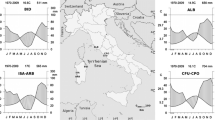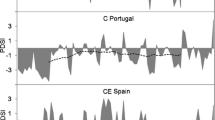Key message
The dataset provides digital dendrometer measurements on stem circumference of irrigated and non-irrigated Pinus pinea trees. Data were obtained in a xeric non-native habitat of central Chile. Forest mensuration was hourly collected from six adult trees during a growth year. This data can be re-used to perform different studies, including growth and tree water status temporal correlations, climate-growth relationships, and to compare stone pine stands growing in native and non-native habitats. Such studies could facilitate decisions for the species management and contribute to the understanding of its growth dynamics in a climate change context, providing valuable information for a climate-smart forestry. Dataset access is at https://doi.org/10.5281/zenodo.6010567. Associated metadata are available at metadata-afs.nancy.inra.fr/geonetwork/srv/fre/catalog.search#/metadata/bcea7f69-2cf1-444b-8e5b-e9feb23683db
Similar content being viewed by others
1 Background
This dataset was recorded during the FONDEF D11I1134 project (http://repositorio.conicyt.cl/handle/10533/108139/browse?type=folio&value=D11I1134) and developed during the Development and contributions for the use of high value forest and fruit-forest species for Chile program (Ministry of Agriculture). Its aims are to identify, to study, and to propose productive alternatives feasible to be established in the country with social, environmental and economic benefits, especially in the context of forecasted warming (IPCC 2021) that makes important the knowledge of forest species growth and its response to hydric deficit.
This tree-level dataset was used to evaluate short-term stem diameter variations (Loewe-Muñoz et al. 2021) at different temporal scales under irrigation and non-irrigation over a 1-year period to answer the scientific question of how the dynamics of seasonal growth and tree water status change in response to environmental factors in a xeric non-native environment (Fig. 1). This study showed that irrigation, besides increasing productivity, also decreased tree sensitivity to temperatures, evapotranspiration and rainfall variability, contributing to the prediction of responses to environmental changes.
2 Methods
Dendrometer data represent a high level of information for research activities on this emergent species in Chile. To evaluate the effect of irrigation on a stone pine plantation, one experimental field trial of 2 ha was designed and realized in the coast of central Chile; 6 plots of 25 trees were established. Between 2014 and 2015, one tree per plot was monitored with high-resolution dendrometers, to characterize seasonal growth dynamics, relevant for forest management purposes (van der Maaten et al. 2018; Zalloni et al. 2018).
We collected hourly stem circumference changes in irrigated and non-irrigated 31-year-old stone pine trees in the 2014/2015 growing year. During this year, below average precipitation for central coastal Chile was recorded (annual hydric deficit (rainfall minus potential evapotranspiration) close to 1000 mm) (Table 1). The dataset contains stem circumference values recorded with high-resolution dendrometers at each hour during 365 days. The time series from each tree are indexed as irrigated or non-irrigated. The generated dataset includes six time series of stem circumference along with air temperature; variables are described in Table 2.
2.1 Site description and experimental design
The study was conducted in a 31-year-old stone pine plantation located in Cáhuil (34°30′ S, 71°59′ W), central Chile, on smooth hills at 125 m a.s.l. The climate is typically Mediterranean, with long dry summers and short intense winter rainfall, with maritime influence of the Pacific Ocean. Average annual climate data indicate annual rainfall of 641 mm, annual evapotranspiration of 1177 mm (estimated from automatically collected average, minimum, and maximum temperatures from dendrometers, with extra-terrestrial radiation values taken from FAO (www.fao.org/3/X0490E/x0490e0j.htm), following Hargreaves and Samani 1985), 6 dry months year−1 and annual average temperature of 13.2 °C (Santibáñez 2017). Drought was recorded during the study period (Table 1). Further climate data can be accessed from DGA Pichilemu (snia.mop.gob.cl/BNAConsultas/reportes). Soil is silty clay loam, granitic, slightly acid (pH = 5.9), with medium organic matter content (3.6%), not salty (E.C. 0.11 mmho cm−1).
The plantation was established on a 30-ha area in winter 1983. A first thinning was applied 20 years after establishment, when 50% of trees were extracted; the first pruning and a second thinning (extraction of 65% of trees, resulting in 285 trees ha−1) were conducted 1 year before establishing the experimental trial in 2014. It involves two treatments, irrigation and control (non-irrigation). Treatments were arranged in a randomized complete block design with three blocks (n = 3). Each plot within blocks had 25 trees. At the beginning of the study (age 31), trees measured on average 5.7 ± 0.35 m, 16.0 ± 1.32 cm, and 3.6 ± 0.34 m for height, DBH, and crown diameter, respectively, with no significant differences among treatments. One representative, regarding growth, central tree per plot was selected to install at breast height (DBH, c. 1.3 m) stem digital band dendrometers (EMS DLR26A with resolution < 1 μm, Environmental Measuring Systems, Czech Republic).
Daily irrigation was provided from spring (September) to autumn (April) using a drip irrigation system. The amount of irrigation was defined as 10% of the expected hydric deficit for the study period, which was calculated in terms of monthly air temperature, precipitation and potential evapotranspiration (PET) of the previous 1-year period (Table 1). Daily irrigation increased from 1.9 L tree−1 in September to a maximum of 5.0 L tree−1 in January, and then decreased to 2.7 L tree−1 in April, totalling 753 L tree−1 year−1.
2.2 Measurements of short-term stem circumference changes
Stem circumference variations were recorded daily at 1-h intervals (00:00 to 24:00 h) from June 2014 to May 2015 using the software EMS Mini32. The temperature in the data logger of the sensor was obtained at 1-h intervals from each dendrometer (Loewe-Muñoz et al. 2022).
2.3 Data access and metadata description
A dataset was generated in csv format, including six time series of stem circumference along with air temperature. The database includes 52,560 measurements (lines) and 6 columns (variables). Mensurational parameter attributes are presented in Table 2.
The database can be downloaded using the following reference and Loewe-Muñoz et al. (2022). A detailed time series of hourly circumference variations in Pinus pinea L. in Chile, https://doi.org/10.5281/zenodo.6010567. Associated metadata are available at metadata-afs.nancy.inra.fr/geonetwork/srv/fre/catalog.search#/metadata/bcea7f69-2cf1-444b-8e5b-e9feb23683db
2.4 Technical validation
Each dendrometer has been carefully checked before publication, avoiding misspelling or errors. The database has been compiled in metric units using the dot as decimal value. The dataset was used in a study conducted in an adult stone pine plantation located in a drought-prone environment in Chile to establish a better understanding of the effect of irrigation on short-term stem diameter changes, and on the sensitivity of the species to weather conditions (Loewe-Muñoz et al. 2021).
2.5 Reuse potential and limits
This original dataset includes forest circumference values of irrigated and non-irrigated P. pinea trees along with air temperature, in a xeric environment in central Chile. This dataset has already been used to analyze short-term stem diameter variations, useful to carry out sustainable forest management.
Regarding the potential use and limits of the dataset, even if the monitored trees were six, the sampling design and the number of repetitions in each treatment may allow the calculation of several forestry-related indices regarding growth and tree water status within and between days, by removing the fitted long-term trend from the stem diameter variations (SDVs) through standardization, including temporal autocorrelations. This dataset is a unique opportunity to develop other research studies, including climate-growth relationships in different environments (Lamas and Rozas 2007); stone pine productivity under different water availability scenarios, useful to study climate change impacts; and to compare Chilean stone pine stands with stands located in the species native habitat and other zones in which P. pinea has been widely introduced (Akyol et al. 2020).
Availability of data and materials
The dataset generated are available in the Zenodo repository, https://doi.org/10.5281/zenodo.6010567
References
Akyol A, Örücü Ö, Seda Arslan E (2020) Habitat suitability mapping of stone pine (Pinus pinea L.) under the effects of climate change. Biol. Plant 75(12):2175–2187. https://doi.org/10.2478/s11756-020-00594-9
Hargreaves G, Samani Z (1985) Reference crop evapotranspiration from temperature. Appl. Eng. Agric. 1:96–99. https://doi.org/10.13031/2013.26773
IPCC (2021) In: Masson-Delmotte V, Zhai P, Pirani A, Connors SL, Péan C, Berger S, Caud N, Chen Y, Goldfarb L, Gomis MI, Huang M, Leitzell K, Lonnoy E, Matthews JBR, Maycock TK, Waterfield T, Yelekçi O, Yu R, Zhou B (eds) Climate Change 2021: The Physical Science Basis. Contribution of Working Group I to the Sixth Assessment Report of the Intergovernmental Panel on Climate Change. Switzerland: Cambridge University Press, p 196
Lamas S, Rozas V (2007) Crecimiento radial de las principales especies arbóreas de la isla de Cortegada (Parque Nacional de las Islas Atlánticas) en relación con la historia y el clima. Invest. Agrar. Sist. Recur. For, http://www.inia.es/GCONTREC/PUB/003-014-(1306)-Crecimiento_1175077539859.pdf Accessed 2019 May 10 16:3. https://doi.org/10.5424/srf/2007161-00993
Loewe-Muñoz V, del Rio R, Delard C, Balzarini M (2021) Short-term stem diameter variations in irrigated and non-irrigated stone pine (Pinus pinea L.) trees in a xeric non-native environment. Ann For Sci 78:99. https://doi.org/10.1007/s13595-021-01114-8
Loewe-Muñoz V, Del Rio R, Delard C, Balzarini M (2022) A detailed time series of hourly circumference variations in Pinus pinea L. in Chile. [Data set]. V3. Zenodo. https://doi.org/10.5281/zenodo.6010567
Santibáñez F (2017) Atlas agroclimático de Chile. Estado actual y tendencias del clima. Tomo III Regiones de Valparaíso, Metropolitana, del Libertador Bernardo O’Higgins y del Maule. Universidad de Chile, Santiago, Chile http://bibliotecadigital.ciren.cl/handle/123456789/26559#.XR0hbJzkYIY.mendeley Accessed 10 May 2021
Van der Maaten E, Pape J, van der Maaten-Theunissen M, Scharnweber T, Smiljanic M, Cruz-García R, Wilmking M (2018) Distinct growth phenology but similar daily stem dynamics in three co-occurring broadleaved tree species. Tree Physiol. 38(12):1820–1828. https://doi.org/10.1093/treephys/tpy042
Zalloni E, Battipaglia G, Cherubini P, Saurer M, De Micco V (2018) Contrasting physiological responses to Mediterranean climate variability are revealed by intra-annual density fluctuations in tree rings of Quercus ilex L. and Pinus pinea L. Tree Physiol 38(8):1213–1224. https://doi.org/10.1093/treephys/tpy061
Acknowledgements
We thank the Araneda family for providing the plantation, water and support for the trial establishment and maintenance.
Funding
The trial establishment and dendrometers were funded by FONDEF, CONICYT [grant number D11I1134], and the data collection and elaboration was funded by the Chilean Ministry of Agriculture [Development and contributions for the use of high value forest and fruit-forest species for Chile, INFOR] and by ANID BASAL FB210015.
Author information
Authors and Affiliations
Contributions
Conceptualization and design of the experiment: VLM and MB. Methodology: VLM and MB. Validation: RDR and CD. Formal analysis: RDR and MB. Investigation: VLM and CD. Resources: VLM. Data curation: RDR. Writing—original draft: VLM and MB. Writing—review and editing: all authors. All authors read and approved the final manuscript.
Corresponding author
Ethics declarations
Conflicts of interest
The authors declare that they have no conflict of interest.
Additional information
Handling Editor: Véronique Lesage
Publisher’s Note
Springer Nature remains neutral with regard to jurisdictional claims in published maps and institutional affiliations.
Rights and permissions
Open Access This article is licensed under a Creative Commons Attribution 4.0 International License, which permits use, sharing, adaptation, distribution and reproduction in any medium or format, as long as you give appropriate credit to the original author(s) and the source, provide a link to the Creative Commons licence, and indicate if changes were made. The images or other third party material in this article are included in the article's Creative Commons licence, unless indicated otherwise in a credit line to the material. If material is not included in the article's Creative Commons licence and your intended use is not permitted by statutory regulation or exceeds the permitted use, you will need to obtain permission directly from the copyright holder. To view a copy of this licence, visit http://creativecommons.org/licenses/by/4.0/. The Creative Commons Public Domain Dedication waiver (http://creativecommons.org/publicdomain/zero/1.0/) applies to the data made available in this article, unless otherwise stated in a credit line to the data.
About this article
Cite this article
Loewe-Muñoz, V., del Río, R., Delard, C. et al. A detailed time series of hourly circumference variations in Pinus pinea L. in Chile. Annals of Forest Science 79, 4 (2022). https://doi.org/10.1186/s13595-022-01132-0
Received:
Accepted:
Published:
DOI: https://doi.org/10.1186/s13595-022-01132-0





